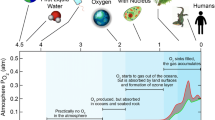Abstract.
Four of the five intermediate oxidation states (S-states) in the catalytic cycle of water oxidation used by O2-evolving photoautotrophs have been previously characterized by EPR and/or ENDOR spectroscopy, with the first reports for the S0, S1, and S3 states available in just the last three years. The first electron density map of the Mn cluster derived from X-ray diffraction measurements of single crystals of photosystem II at 3.8–4.2 Å resolution has also appeared this year. This wealth of new information has provided significant insight into the structure of the inorganic core (Mn4O x Ca1Cl1–2), the Mn oxidation states, and the location and function of the essential Ca2+ cofactor within the water-oxidizing complex (WOC). We summarize these advances and provide a unified interpretation of debated structural proposals and Mn oxidation states, based on an integrated analysis of the published data, particularly from Mn X-ray absorption spectroscopy (XAS) and EPR/ENDOR data. Only three magnetic spin-exchange models for the inter-manganese interactions are possible from consideration of the EPR data for the S0, S1, S2 and S– N (NO-reduced) states. These models fall into one of three types denoted butterfly, funnel, or tetrahedron. A revised set of eight allowed chemical structures for the Mn4O x core can be deduced that are shown to be consistent with both EPR and XAS. The popular "dimer-of-dimers" structural model is not compatible with the possible structural candidates. EPR data have identified two inter-manganese couplings that are sensitive to the S-state, suggesting two possible bridging sites for substrate water molecules. Spin densities derived from 55Mn hyperfine data together with Mn K-edge energies from Ca-depleted samples provide an internally consistent assignment for the Mn oxidation states of Mn4(3III,IV) for the S2 state. EPR and XAS data also provide a consistent picture, locating Ca2+ as an integral part of the inorganic core, probably via shared bridging ligands with Mn (aqua/hydroxo/carboxylato/chloro). XAS data reveal that the Ca2+ cofactor increases the Mn(1s→4p) transition energy by 0.6–1 eV with minimal structural perturbation versus the Ca-depleted WOC. Thus, calcium binding appears to increase the Mn-ligand covalency by increasing electron transfer from shared ligands to Mn, suggesting a direct role for Ca2+ in substrate water oxidation. Consideration of both the XAS and the EPR data, together with reactivity studies on two model complexes that evolve O2, suggest two favored structure types as feasible models for the reactive S4 state that is precursor to the O2 evolution step. These are a calcium-capped "cuboidal" core and a calcium-capped "funnel" core.
Similar content being viewed by others
Author information
Authors and Affiliations
Additional information
Electronic Publication
Rights and permissions
About this article
Cite this article
Carrell, T., Tyryshkin, A. & Dismukes, G. An evaluation of structural models for the photosynthetic water-oxidizing complex derived from spectroscopic and X-ray diffraction signatures. J Biol Inorg Chem 7, 2–22 (2002). https://doi.org/10.1007/s00775-001-0305-3
Received:
Accepted:
Published:
Issue Date:
DOI: https://doi.org/10.1007/s00775-001-0305-3




